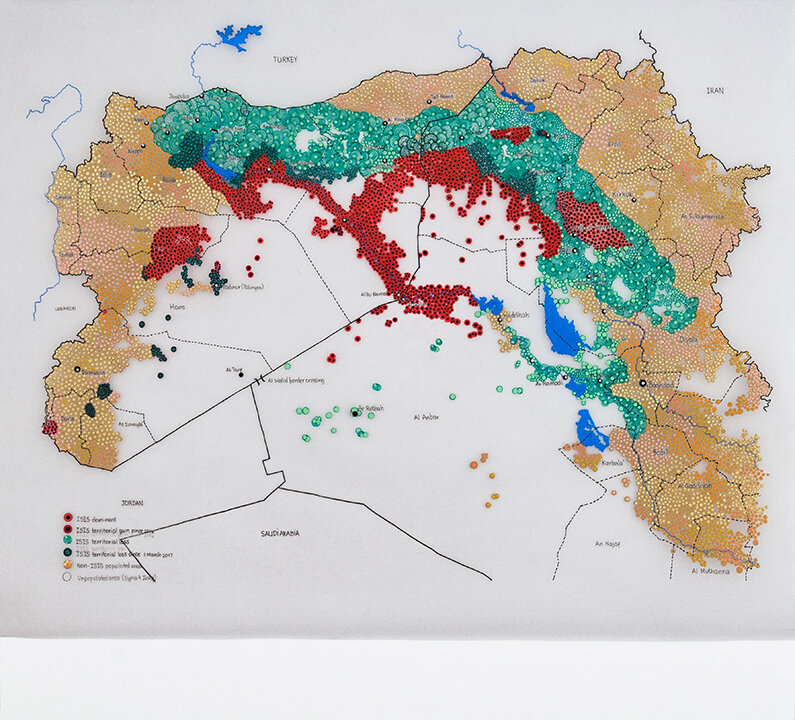
The Syria Project: Tracking Conflict and Displacement | 2015-ongoing
Dignity Revolution | 2014-2020
ISW: areas of control; UNHCR: numbers & locations of Syrian refugees and IDPs as of April 2019 | 2019 | 76 x 93 cm
Charles River Editors, ISW–The Battle for Ancient Palmyra | 2018 | 96.5 x 63 cm
ISW/NYT/DEBKAfile: areas of control as of Sep 2018 and military positions of Syrian Regime, Russia, Iran & Proxies, and US-led Coalition as of April 2018 | 2018 | 76 x 93 cm
ISW: ISIS control, attack, support zones (Oct 2018); HIU, UNHCR: Regional Displacement, numbers & locations of Syrian refugees and IDPs (Sept-Oct 2018) | 2018 | 77 x 100 cm
Global Coalition–mapping a conflict without border: areas of influence in Syria and Iraq | 2017 | 51 x 56 cm
HIU/UNHCR/UN OCHA/UNRWA/USG/Gov of Turkey: numbers and locations of Syrian refugees and IDPs in the region | 2017 | 51 x 56 cm
UNHCR/AFP: numbers and locations of Syrian refugees worldwide | 2017 | 51 x 56 cm
UNHCR: total Syrian asylum applications in Europe (April 2011–May 2015) & admissions (Feb 2015) | 2015 | 30 x 21 cm
ECHO/OCHA/UNHCR/SNAP: Syrian refugees, IDPs and people in need in Iraq & Syria (winter 2014-2015 and as of July 2015) | 2015 | 25 x 31.2 cm
Life, which you look for, you will never find–the ancient Near East | 2015 | embroidery, beads, plastic gems | 85 x 115 cm
Related exhibitions:
Migration Politics: Three CAMP exhibitions at the SMK | Statens Museum for Kunst, Copenhagen | 2016
from the mountains to the valleys, from the deserts to the seas | CAMP Center for Art on Migration Politics, Copenhagen | 2015
New Cartographies | Asia Society Texas Center | 2018-2019
The Syria Project emerged in tandem with Chung’s deepening investigations into the post-1975 worldwide exodus of Vietnamese seeking to flee the newly unified Communist state. With her own memories of the refugee experience, Chung’s preoccupation with the current war in Syria has inspired research into the crisis and her ongoing tracking of the conflict and displacement of Syrians. The Syria Project also relates to the research carried out for Scratching the Walls of Memory, as Chung tracks historical mapping projects in the Middle East carried out by colonial regimes, namely Great Britain and France. The politically constructed borders, such as the one drawn as a result of the 1916 Sykes-Picot Agreement, bore deeper ramifications for human populations then and now. The impact of this colonial partitioning in the Middle East provides context for the ongoing conflict in Syria, in which large-scale massacres, bombings, use of chemical warfare, and escalating refugee numbers have reached about 6.8 million and 6.7 million IDPs (Internally Displaced Persons). Giving alternative form to the numbers and data, The Syria Project comprises cartographic drawings referencing dates and areas of conflict and control, or the growing numbers of refugee camps, refugees, and IDPs. Tracking statistical data related to urban destruction, civilian deaths, refugee and IDP numbers, selected focal matter was extracted and codified through dots, circles, and lines in a body of map drawings exhibited at the 56th Venice Biennale. The panoply of 40 drawings presented in its central exhibition All The World’s Futures, carefully displayed on the wall like a geometric arrangement of tesserae, simulates the clusters of painstakingly rendered marks within each frame, each a portrait of crumbling humanity. With their statistical basis and acutely empirical titles, such as Syria Tracker: numbers of children killed in different governorates, March 2011-November 2014, or her latest tracking ISW: areas of control; UNHCR: numbers & locations of Syrian refugees and IDPs as of April 2019, the intoxicatingly aesthetic presentation attempts to still the audience and bite into our senses. These are precisely rendered infographic topographies, mesmerizing for the minute dots and circles condensed or dispersed, floating or receding, in coloristic tapestry-like patterns. Yet each mark – representing numbers of lost or displaced lives – speaks to a scale of brutality and dehumanization that is inescapably delimited and hollowed out in data records comprising never-ending lists of numbers.
◀︎ ▶︎ All Projects










